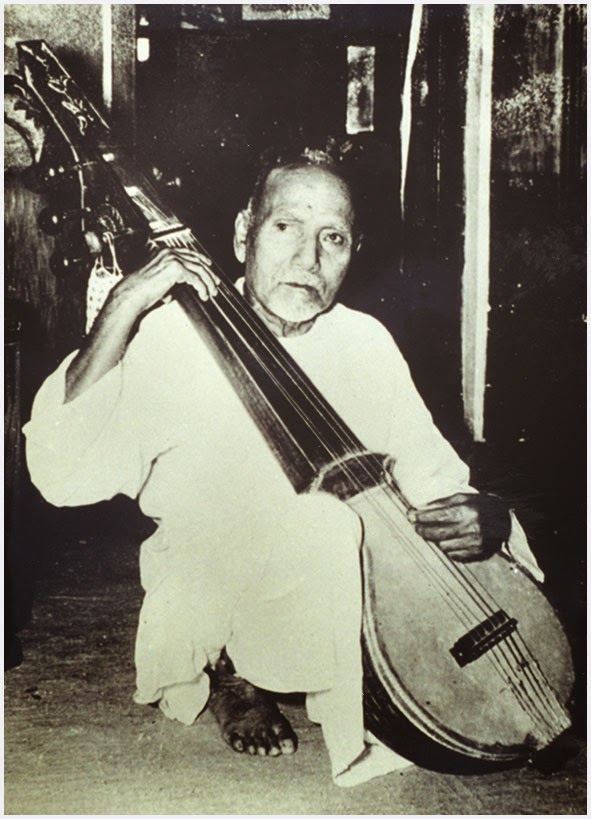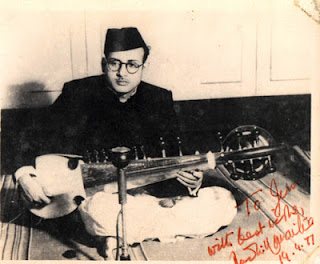Ustad Allauddin Khan playing the Sursringar
Sursringar is a very rare instrument from India used in the past as an instrument for Dhrupad style Alaps. It got forgotten and nearly extinguished in the second half of the 20th century. Nowadays there a number of younger artists, basicly Sarod palyers, who occasionally play this in strument, but almost always like a Sarod.
Here we present two older recordings by two great masters. Both have strong Dhrupad backgrounds, the first through his teacher, the Beenkar Ustad Wazir Khan of the Senia Gharana (direct descendant of Tansen), the second through one of his teachers, the Beenkar Ustad Dabir Khan, grandson and student of Wazir Khan. These recordings we found a while ago in the internet. Many thanks to the original uploaders: the first one I don't remember unfortunately, the second one being Abhimonyu Deb from Kolkata. A note about the pictures: normally the Sursringar is hold against the left shoulder, but because of Ustad Allauddin Khan being lefthanded he holds it to his right shoulder.
1. Ustad Allauddin Khan
Raga Nat (31:02)
A recording from All India Radio
Download

Ustad Allauddin Khan playing the Seni or Dhrupad Rabab
2. Pt. Radhika Mohan Maitra
Raga Jaunpuri (30:26)
A recording from All India Radio

Pt. Radhika Mohan Maitra playing the Sarod
Sursringar
Another instrument that appeared in Hindustani music in the early years of
the nineteenth century was the Sursringar, which was analogous to
surbahar.
Sursringar is a modified version of the Seniya rabab. The instrument rabab
had some limitations. Its gut strings and skin parchment upon the resonator make
the slow passages of alapchari, impossible unlike the been. Moreover, due to the
dampness in the monsoons, the sound of rabab used to deteriorate so much that
the notes played on it could not even be discerned. In Sursringar, the skin
parchment of the resonator had been replaced by a wooden sound board, the gut
strings by those of steel and the wooden fingerboard was covered with a thin
iron sheet. With these modifications Sursringar became a distinct improvement
over the rabab with regard to the tonal quality and for the alapchari of dhrupad
anga. These modifications, in the rabab were carried out by a descendant of
Tansen's named Jaffar Khan.
Sursringar was well-suited for vilambit (slow) alap, and the techniques of
both veena and rabab playing could be incorporated in it. The melodious effect
of Sursringar was so overpowering that it could even outshine the veena in its
vilambit alap. Thereafter, it became a tradition amongst the Rababiya gharana to
play the Sursringar during the rainy season.
The instrument was well received in the world of music and became popular
in a very short time in northern India.
Sursringar and surbahar, both these instruments were meant for playing the
dhrupad anga alap in an elaborate manner. Sarod players used to play alap on the
Sursringar before playing gat toda on sarod in the same manner as sitar players
used to play on the surbahar before playing gat toda on the sitar. Therefore, it
was customary to learn the Sursringar along with the sarod till the early years
of the twentieth century. Gradually, when the sarod and sitar were modified and
became well equipped with greater range of expressiveness, the popularity of the
Sursringar and surbahar ebbed and these became obsolete in the latter half of
the twentieth century.
from:
http://www.india-instruments.de/instrumente/instrumentenlexikon/sursringar.html
Sursringar: Making way for sarod ?
is the popularity of sarod responsible for elbowing out sursringar from
circulation, asks richa bansal unlike most other instruments in hindustani
classical tradition, sursringar, which falls in the category of stringed
instruments, can be dated back to a specific time. it was devised, according to
traditional accounts, by the great rabab player jafar khan in or around the year
1830. organologically, a cross between rabab and surbahar but with a distinct
sound and string system, sursringar is fast declining in the modern age.
sursringar consists of a large semi-spherical gourd sounding box covered with
wood fitted to a hollowed tapering wooden stem. the stem has a steel plate
attached to it with steel and brass wires stretched across the plate. in its
present form sursringar has six main strings and three subsidiary strings. it is
played with a stiff wire plectrum called 'java'. the traditional style or baaz
of sursringar is extremely difficult and is slowly dying out. the instrument was
mainly used for playing alaap in the complex dhrupad system. it has a marvellous
tone and depth of sound and is held upright like a been or sitar during a
performance. pyar khan, jafar khan and bahadur sen khan were some of the great
exponents of sursringar. in bengal, ustad allauddin khan, kumar birendrakishor
roychwdhury, shaukat ali khan and pandit radhika mohan maitra were the noted
sursringar players. trained under ustad ali akbar khan and shri dhyanesh khan,
anindya banerjee is virtually the only practising exponent of sursringar in its
traditional style in india today. anindya banerjee, who is originally trained in
sarod, "fell in love" with sursringar when he heard a recording of ustad
allauddin khan playing the instrument sometime in the 1970's. it was much later
in the 80's that he decided to revive it and his ensuing efforts since then
deserve high praise. "i was the first to take this instrument abroad and use it
in ballet music in the dhrupad festival in uk organized by amc in 1992," said
banerjee. "i have also used it in the background music of some kolkata tv
serials," he added. he has even taught music in canada in 1984 and is scheduled
to leave for uk in coming november. invited to various other prestigious music
festivals both in india and abroad, banerjee's cd's are expected to be released
fairly soon by an american as well as a french company. banerjee feels that
sursringar has declined primarily since ustad allauddin khan incorporated the
different styles of rabab, sarod and sursringar into sarod alone. this made
sarod so versatile that gradually sursringar and rabab lost their popularity.
besides, he explains that the instrument, being very large in size, poses
difficulty in transportation. the sitting style of sursringar is verasan is
extremely difficult to learn. lastly, it is not an easily affordable instrument
priced between rs 30-50,000. "while five years is the maximum time a student
requires to learn sursringar it is much easier for a sarod student to learn it,"
feels banerjee drawing on his own experience. anindya banerjee owns a relatively
new sursringar instrument made from tunkat with its tabli recently replaced with
200-year-old teakwood. "initially sursringar was made from teak but nowadays
only tunkat is used," he said. "the main maker of sursringar in kolkata today is
hemen and company with instruments ranging from rs 30,000 onwards," he added.
essentially a connoisseur's delight,sadly enough, sursringar is now hardly
played in front of mass audiences. however, banerjee feels that with proper
instruction, it will be possible to play this instrument alongside sarod and
sitar on the concert stage some day. strongly maintaining that classical music
still has its select audience, even banerjee could not help but agree with the
fact that the quality had deteriorated immensely over the past years. and
sursringar is no exception to this rule.
from: http://timesofindia.indiatimes.com/city/calcutta-times/Sursringar-Making-way-for-sarod-/articleshow/1375957068.cms
See also this note about Anindya Banerjee and a recording hopefully to get published one day:
![[RMM.jpg]](../3.bp.blogspot.com/_ikNA-qTOdWM/SloNq4JTOfI/AAAAAAAAAkQ/fO6tUvN_NXw/s400/RMM.jpg)
